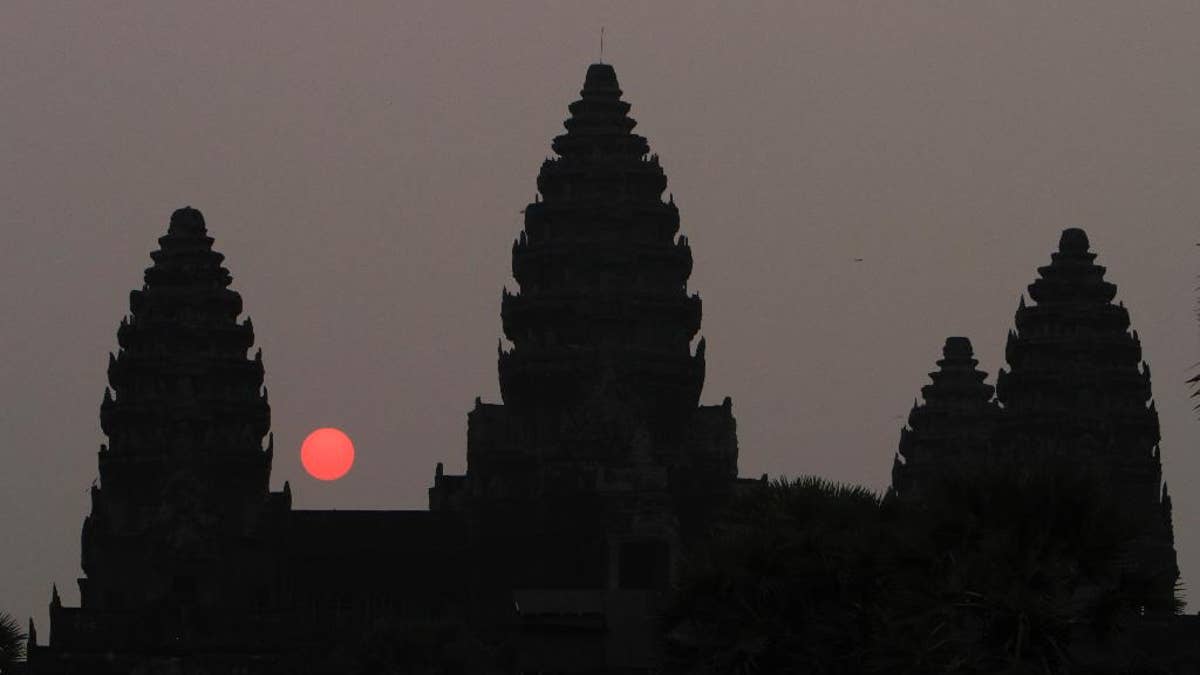
Angkor Wat file photo (iStock)
The events that led to the demise of the ancient Cambodian megacity of Angkor have been shrouded in mystery for centuries. However, new research argues that the city’s fall may have been a gradual process as opposed to a single catastrophic event.
“New scientific evidence shows that the intensity of land use within the economic and administrative center of the city declined gradually more than 100 years before the supposed collapse, implying a very different end to the city,” scientists from the University of Sydney explain in a statement.
Sediment drill-cores extracted from the moat surrounding the city’s walled citadel of Angkor Thom offer a vital clue, according to the experts.
LOST CITY IN SOUTH AFRICA REVEALED IN STUNNING DIGITAL IMAGES

In this Friday, March 20, 2015, file photo, the sun rises behind Angkor Wat at the eastern site of Siem Reap province, some 143 miles northwest of Phnom Penh, Cambodia. (AP Photo/Heng Sinith, File)
Surrounded by dense jungle, the vast city was home to the famous Angkor Wat temple complex and was once the thriving capital of the ancient Khmer Empire. At one point, the population of Angkor may have been over 1 million people, according to LiveScience.
The circumstances surrounding Angkor’s demise have been debated for years. One theory suggested that aggression from neighboring states forced the city’s abandonment in 1431.
MYSTERIOUS LOST MAYA CITIES DISCOVERED IN GUATEMALAN JUNGLE
"Changes in land use leave tell-tale traces in sedimentary deposits that can be measured. Measuring these traces in drill-cores allows us to reconstruct what people were doing in the landscape over long periods of time," said Dan Penny, an associate professor at the University of Sydney's School of Geosciences, in the statement.

Scientists have a new theory about the collapse of the ancient city of Angkor in Cambodia. (The University of Sydney)
By studying the sediment, scientists found that forest disturbance, soil erosion and burning all declined in the first decades of the 14th century. This, they explain, suggests a sustained decline in land-use at the heart of the ancient city. By the end of that century, the moat was covered in floating vegetation, which could indicate that it was no longer maintained.
"Our study suggests the inhabitants didn't leave Angkor because the infrastructure failed, rather the infrastructure failed (or was not maintained or repaired) because the urban elite had already left," said Penny, in the statement.
LONG-LOST ANCIENT CITY BUILT BY TROJAN WAR PRISONERS DISCOVERED IN GREECE
Experts from the Ecole Française d'Extrême-Orient and Australia’s Flinders University also participated in the research, which is published in the Proceedings of the National Academy of Sciences journal.

FILE - In this July 14, 2014 file photo, tourists look at the view of the Angkor Wat temples at sunrise, outside Siem Reap, Cambodia. (AP Photo/Anat Givon, File)
A World Heritage Site that dates back to the 9th century A.D, Angkor is described by UNESCO as "one of the most important archaeological sites in South-East Asia." The Angkor Wat temple complex is one of the largest religious monuments ever built, according to LiveScience.
CLICK HERE TO GET THE FOX NEWS APP

File photo - Angkor Wat temple, Siem reap, Cambodia. (iStock)
While often described as a ‘lost city,’ Angkor was known to local people after the city’s abandonment. A Portuguese Capuchin friar, Antonio da Madalena, is said to be the first European to visit the city, in 1586.
Follow James Rogers on Twitter @jamesjrogers
